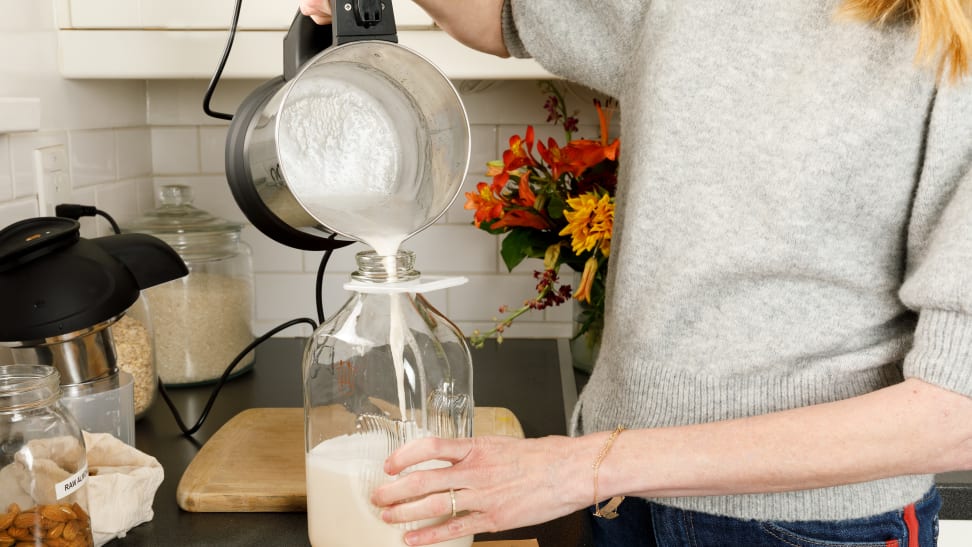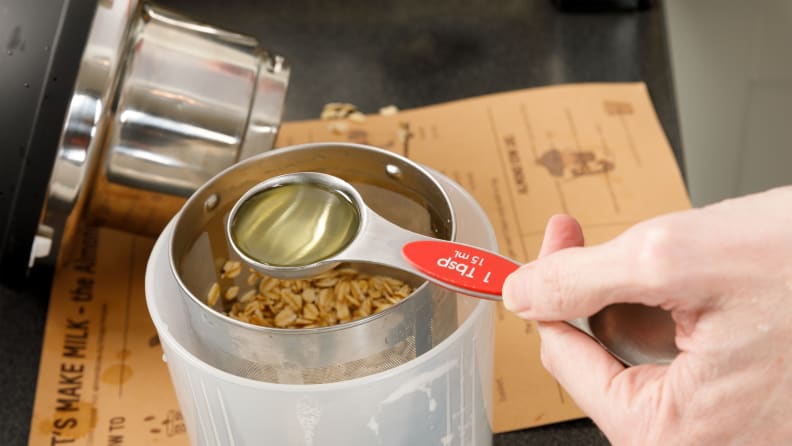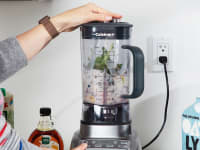Is this popular appliance the secret to easy homemade almond milk?
We tried Almond Cow to find out
 Credit:
Reviewed / Lisa Lawrence
Credit:
Reviewed / Lisa Lawrence
Products are chosen independently by our editors. Purchases made through our links may earn us a commission.
We at Reviewed are just as curious about those flashy products we see in our Instagram feeds as you are. For our 'As Seen On IG' series, our writers put them through their paces to find out if they're actually as good as they look online—or too good to be true. Spot one that we've missed? Email us at [email protected].
When I first went dairy-free 14 years ago, there weren’t a lot of milk alternatives to choose from. That may seem hard to believe now that we live in a world full of every kind of nut and grain milk imaginable, but my choices at the time were limited to soy milk (gross), or expensive—and tiny—boxes of almond milk. Faced with a future of having to drink my coffee black (ick) or finding a more affordable alternative, I started making my own almond milk.
Making your own nut milk is easy, but it’s also time-consuming and messy. First, you have to soak your almonds in water overnight—a step that I consistently failed to remember. Then you blend your soaked almonds with some fresh water and a splash of vanilla, after which you have to strain the whole shebang through a nut milk bag. Squeezing all the resulting “milk” out of the almond puree is messy—it always ended up all over me and my kitchen—and takes quite a bit of (literal) handwringing. Nevertheless, I persisted in my pursuit of creating the perfect homemade almond milk... until I had a child.
While I may have initially harbored grand plans of continuing to prepare homemade almond milk for both myself and my offspring, I quickly learned that this was about as realistic a dream as me becoming the Queen of England. Have you ever tried to squeeze nut milk while also holding a screaming baby? Yeah, don’t do it. Thankfully, Trader Joe’s got on the almond milk train right around the time I had my first kid, and we’ve been drinking their almond milk ever since.
However, when I saw the ad on my Instagram feed for Almond Cow, the plant-based milk maker, I was excited. I’ve been wanting to get back to making homemade almond milk, and this looked like a much easier way to go about it.
What is Almond Cow?
Billed as “the plant based milk maker” the Almond Cow is a one-step appliance for whipping up homemade nut and grain milks. It purports to make a variety of plant-based milks in minutes, and touts that it’s easy to clean and requires no straining(!).
The Almond Cow starter set costs $325(!!), and includes the milk maker, a 60-ounce glass milk jug, a jug-cleaning brush, 3-pound bags of raw almonds, oats, and cashews, and a 2-pound bag of coconut shreds. If you prefer to order the components separately, the milk maker has a price tag of $245, and the glass jug sells for $16.95.
Here’s a sign that Instagram ads work: The product is so popular that it took almost two months for my Almond Cow to arrive. By the time it showed up on my doorstep I’d completely forgotten that I’d ordered it!
How does Almond Cow work?

The Almond Cow has a built-in blender and filter basket.
Essentially, the Almond Cow does all of the work for you with the push of a button. You still have to remember to soak the nuts overnight—it makes the milk creamier—but it will work if you’re just incapable of planning ahead (ahem, me).
Attached to the top of the Almond Cow is what appears to be a small immersion blender. You fill up the stainless steel filter basket with your plant-based ingredients, screw it onto the blade section, and then add water to the base of the pitcher. The Almond Cow runs through three blending cycles—there’s a blinking cow-shaped light on the top to let you know when it’s done—and after a few minutes you have five to six ounces of fresh “milk.”
How I tested the Almond Cow

Almond Cow's site offers lots of recipes for alternative milks, including oat.
I really wanted to put the Almond Cow through its paces, so I made multiple batches of different kinds of milk. I followed the recipes from the Almond Cow website in order to ensure that I got the proportions right. Here’s what I made:
- Almond milk with not-soaked raw almonds (in classic Anna fashion)
- Oat milk
- Coconut milk
- Almond milk with soaked raw almonds
Both versions of the almond milk were delicious. The soaked almonds produced a creamier milk with less of a bitter finish, but each was a great consistency and really tasty. My kids are used to commercially produced almond milk (#momfail) and they thought it was “gross” because it tasted so much like raw almonds, but I loved adding it to my coffee in the morning.
The oat milk produced by the Almond Cow was the best oat milk I’ve ever had—yes, tastier than Oatly—and so easy to make. It was so creamy and not grassy tasting, and even my picky kids drank it when I warmed it up (and mixed it with chocolate).
The coconut milk was an epic fail. I used thawed coconut meat, which the recipe said would work, but it produced milk that was watery and vile. If you’re expecting to end up with the thick, fatty milk you’d get from a can of coconut milk, you won’t get that from the Almond Cow. I dumped the whole batch down the drain because it was not appealing whatsoever.
What I didn’t like about Almond Cow
My two biggest complaints about Almond Cow have to do with the filter basket. I did not find unscrewing the basket to be intuitive. In order to lock and unlock the filter basket, one has to turn it the opposite of what one would normally do. No “righty tighty, lefty loosey” here, but rather the other way around.
I also found it tough to attach the basket to the blade when it was filled with nuts or grains, because it’s difficult to push the blade through the foodstuffs to the bottom of the basket. The directions say to shake the basket around a bit, but that didn’t really work. Most of the time, I had to dump out a handful of the nuts or grains in order to secure the basket to the blade, which I found annoying and messy, and which sometimes resulted in slightly watered-down milk.
Should you buy the Almond Cow?

The homemade oat milk was truly delicious.
Simply put, it makes preparing your own plant-based milks incredibly easy. If you want to move away from mass-produced nut, grain, or seed milks either because of cost or ingredients, the Almond Cow simplifies the process. With the touch of a button (and a bit of prior planning) you can be enjoying your favorite plant-based milk in a few minutes.
But if your aim is to save money on store-bought products, well, you’ll have to make a lot of six-ounce Almond Cow batches to justify its nearly $250 price (plus the cost of the raw ingredients). That said, if you’re committed to making your own plant-based milks—and you have an extra $250 sitting around—it’s worth purchasing.


